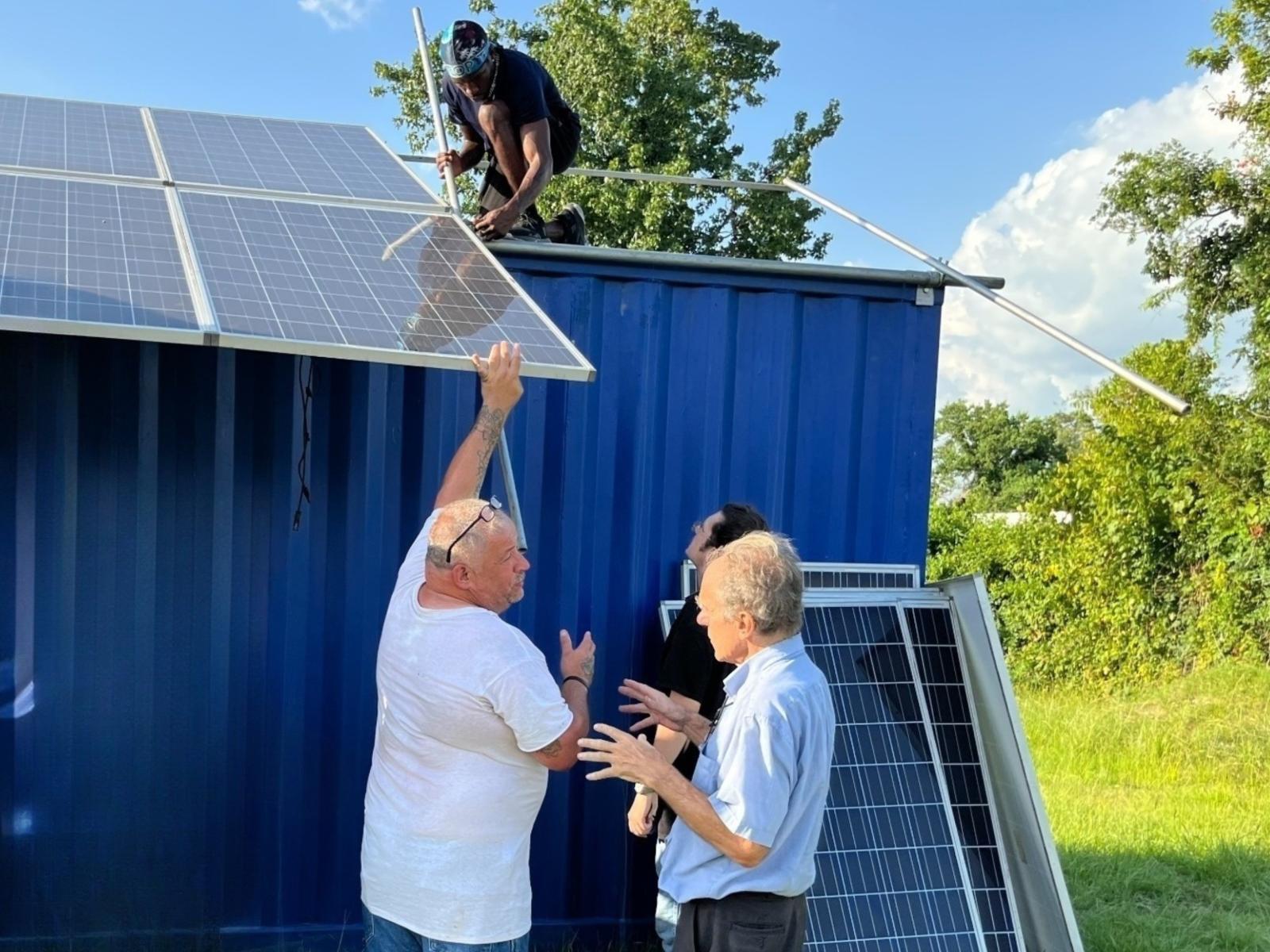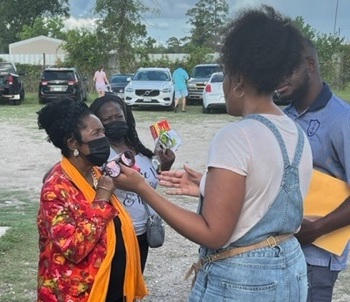Collaborative Effort Empowers Disadvantaged Communities to Join the Clean Energy Revolution
PNNL and Launch Point join forces to develop guidance and resources for community organizations

A young trainee installs solar panels as part of a class project for Launch Point’s new solar installation training curriculum. (Photo courtesy of Launch Point CDC, Inc.)
When all communities have access to clean energy and energy-efficient technologies, everyone wins. Community members can lower their utility bills, thereby decreasing energy burdens while also increasing comfort within their homes. The larger community experiences economic development through new job and training opportunities. Even the electric grid wins, as energy efficiency increases overall system stability.
The communities that can benefit the most from such technologies, however, often lack the resources and support to implement them at scale. Community organizations are well-positioned to facilitate clean energy programs—but because they rely on limited funding and employee or volunteer bandwidth, many don’t know where to start.
That’s why Pacific Northwest National Laboratory (PNNL) and Launch Point CDC, Inc. (a community organization in Houston, Texas) are developing a framework to empower disadvantaged communities with clean energy technology—along with a set of resources to give other community organizations a head start.
Origin story

The story begins with systems engineer Dr. Ebony Mayhorn (PhD, electrical engineering), who started her career at PNNL as an intern focusing on projects related to electrical grid efficiency. Her work began merging with building science when a building-grid integration initiative began preparing for a future in which buildings routinely “talk” with the power grid to optimize the supply and demand of energy to meet our needs.
When the Justice 40 Initiative launched with the aim of directing 40 percent of the overall benefits of certain federal investments (including clean energy and energy efficiency) to disadvantaged communities, Dr. Mayhorn saw an opportunity to bring a new passion and meaningful purpose to her work.
“I grew up in a disadvantaged community, where I witnessed the devastating impacts that inequities have on both children and adults, along with their homes and businesses,” Dr. Mayhorn said. “I jumped at the chance to integrate energy justice and equity into my work so that I could help similar communities—realizing a gap would need to be bridged between the availability of new opportunities for residential energy savings and actually getting relevant technologies into homes.”
“Determining what upgrades homes need and applying for funding can take knowledge and time that individual homeowners may not have,” Dr. Mayhorn continued. “I started thinking—‘If community organizations had the resources to coordinate these kinds of efforts at scale, they could really make an impact toward bringing clean energy technologies to disadvantaged communities. How can we help empower them?’”
Houston, we have a solution

Supported by funding from the Department of Energy’s Building Technologies Office, the solution being co-developed by PNNL and Launch Point involves a demonstration project. By actually going through the process of launching a clean energy program in Northeast Houston, the team aims to identify practical dilemmas communities will likely face, along with strategies for overcoming them. By documenting their processes and findings, they can also develop guidance for other communities launching similar programs.
First, the team knows that community organizations will need a way to identify the energy technologies and upgrades that best address community-specific needs, based on factors such as local climate, home conditions, and energy prices. For the Houston project, PNNL conducted analyses to evaluate common energy retrofit scenarios using partner-provided and publicly available resources, tools, and data. The analysis considered common energy technologies and approaches that may benefit Houstonians, such as heating, ventilating, and air conditioning (HVAC) upgrades; air sealing and insulation; and installation of heat pumps, heat pump water heaters, photovoltaics, and battery storage.
Next, the team turned this knowledge into actionable steps. They focused on two parallel efforts: engaging and educating the community on clean energy opportunities while developing a local workforce training program to meet the community’s anticipated growth in demand for HVAC-related retrofits and upgrades.
The next chapter
While the demonstration in Houston is still underway, the team is already sharing valuable information, guidance, and resources with other community organizations. PNNL’s Community Clean Energy Resources webpage contains details about the team’s evolving community engagement and workforce training approaches, and updates are posted regularly.
Meanwhile, the team’s next challenge is another gap to bridge—the funding gap. “We’re still working to overcome the barrier of upfront costs to implement clean energy solutions we’re targeting,” Dr. Mayhorn said. “More incentives for such upgrades are becoming available to homeowners through multi-level programs and legislation but may not offer a complete funding solution. Plus, we’re finding that many homes require some level of repair before an energy upgrade can happen, such as roof replacement or mold remediation.”
Ultimately, the team knows that leveraging available opportunities at scale will take significant coordination on a local level and wants to do everything it can to prepare and support community organizations and others who will be undertaking these heroic efforts. This epic story is still being written—stay tuned.
Additional PNNL researchers participating in this effort include Tabitha Artuso, Cheryn Metzger, Tyler Pilet, and Andrew White.
Revised: October 24, 2023 | Published: October 25, 2023